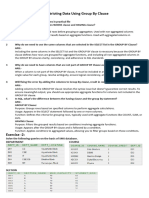0% found this document useful (0 votes)
21 views2 pagesMySQL GroupBy Having Practice
This document contains a collection of MySQL queries focused on the GROUP BY and HAVING clauses, organized into Basic, Intermediate, and Advanced levels. Each section includes specific questions along with corresponding SQL solutions related to the 'employees' table. The queries cover various aspects such as counting employees, averaging employee numbers, and filtering results based on conditions.
Uploaded by
Praveen Reddy DakaCopyright
© © All Rights Reserved
We take content rights seriously. If you suspect this is your content, claim it here.
Available Formats
Download as PDF, TXT or read online on Scribd
0% found this document useful (0 votes)
21 views2 pagesMySQL GroupBy Having Practice
This document contains a collection of MySQL queries focused on the GROUP BY and HAVING clauses, organized into Basic, Intermediate, and Advanced levels. Each section includes specific questions along with corresponding SQL solutions related to the 'employees' table. The queries cover various aspects such as counting employees, averaging employee numbers, and filtering results based on conditions.
Uploaded by
Praveen Reddy DakaCopyright
© © All Rights Reserved
We take content rights seriously. If you suspect this is your content, claim it here.
Available Formats
Download as PDF, TXT or read online on Scribd
/ 2









































































